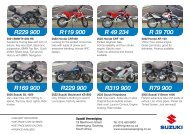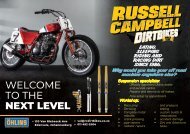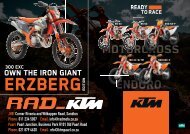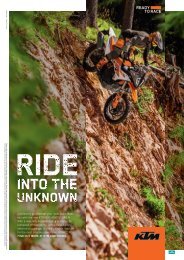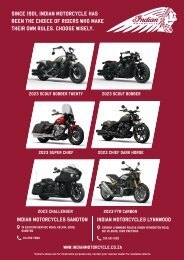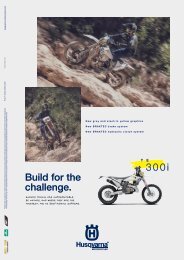Create successful ePaper yourself
Turn your PDF publications into a flip-book with our unique Google optimized e-Paper software.
DON’T ‘BRAKE’ A SWEAT<br />
Brake fluid:<br />
When was the last time you flushed your brake fluid? Yup you<br />
need to do it occasionally.<br />
Brake fluid is a hydraulic fluid and it is designed to withstand<br />
high temperatures with very low compressibility (Viscosity).<br />
Brake fluid is a glycol-ether-based (DOT3 and 4) or a siliconebased<br />
(DOT 5) fluid. Remember that these are not compatible, so<br />
don’t get them mixed up.<br />
Use whatever is imprinted on your front brake master cylinder.<br />
DOT3 or DOT4 fluid is hygroscopic, which means it absorbs<br />
atmospheric water and that degrades its performance over time.<br />
Swap your brake fluid occasionally and make sure that you bleed<br />
the system correctly.<br />
More on that in future issues.<br />
Brake pads …<br />
Now this is where things start getting really complicated and<br />
quite interesting. Each manufacturer uses their own codes,<br />
own descriptions and have several variants of each compound<br />
focused on different types of motorcycles, riding style, racing<br />
disciplines and all that.<br />
Wading through each brands different brake pad compounds<br />
could easily fill several magazines for a year. So we have decided<br />
to brake it down into the basic pads and level of motorcycle<br />
application and riding. If you would like to delve in deeper to<br />
compounds and all that, Google is your friend.<br />
The three fundamental compound types are: sintered, organic<br />
and semi-metal. Sintered pads are sometimes called “metal”<br />
or “metallic”. Organic pads are sometimes called “resin”.<br />
Each of these three compounds has their own benefits and<br />
disadvantages.<br />
Organic Brake Pad<br />
Sintered Brake Pad<br />
Organic Pads: Essentially an entry level brake pad designed<br />
more for the commercial, scooter, classic and cruiser market.<br />
The pads are made for bikes that do not travel at exceptionally<br />
high speeds and do not generate excessive heat on the discs<br />
and pads while braking. They are the softest form of brake<br />
pad, non-metallic pads are made up of different combinations<br />
of glasses, rubbers and resins like cellulose along with a small<br />
smattering of metal fibres that are all manufactured and cured<br />
to withstand a substantial amount of heat. The composite that<br />
results is relatively soft and therefore wears away quickly, but is<br />
easy on brake discs. This makes them poor for anything other<br />
than daily road driving, and even then a more metal-based pad is<br />
preferable to avoid frequent replacement.<br />
The accelerated wear of organic pads results in large amounts of<br />
brake dust covering nearby components which can also become<br />
a bit of a pain. Originally constructed from Asbestos (due to<br />
its talent for dissipating heat) non-metallic pads were swiftly<br />
switched to other compounds due to the health and safety<br />
issues revolving around the toxic material once airborne.<br />
Sintered Brake pads:<br />
Typically made using sintered steel, graphite or iron, semimetallic<br />
brake pads have a high thermal conductivity and –<br />
when combined with proper brake ducting for cooling – can be<br />
everything a high performance bike needs to cope with, even on<br />
the most intense of track days.<br />
Sintered brake pads are constructed from materials able to<br />
withstand more aggressive usage with higher friction and heat<br />
dissipation. Basically used on all modern dirt bikes, adventure<br />
bikes, cruisers, tourers and sport bikes.<br />
They offer good, consistent braking from cold all the way through<br />
to coping much better with higher heat generated from higher<br />
speeds, more extreme braking from riding style, faster speeds<br />
and heavier bikes.<br />
In short, they offer better thermal stability, fade free braking with<br />
good pad life and low disc wear.<br />
And there are lots of different types of sintered pads…<br />
Manufacturers offer a different sinter compound for rear and<br />
front brakes, maxi-scooter brake pads for those bigger,






